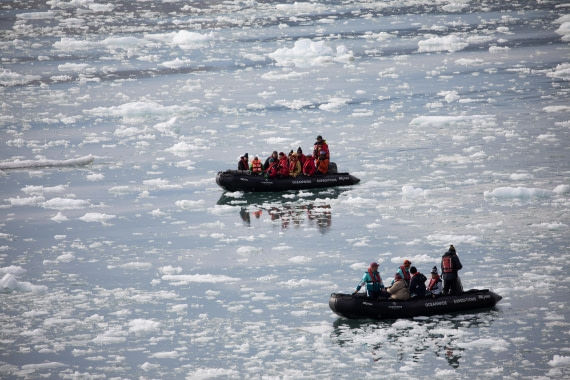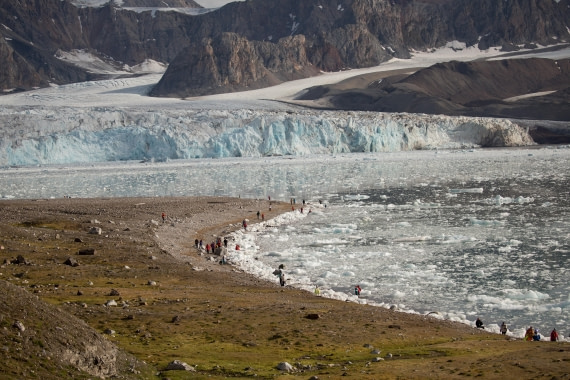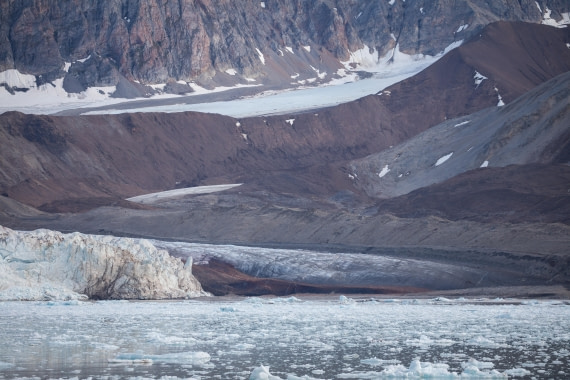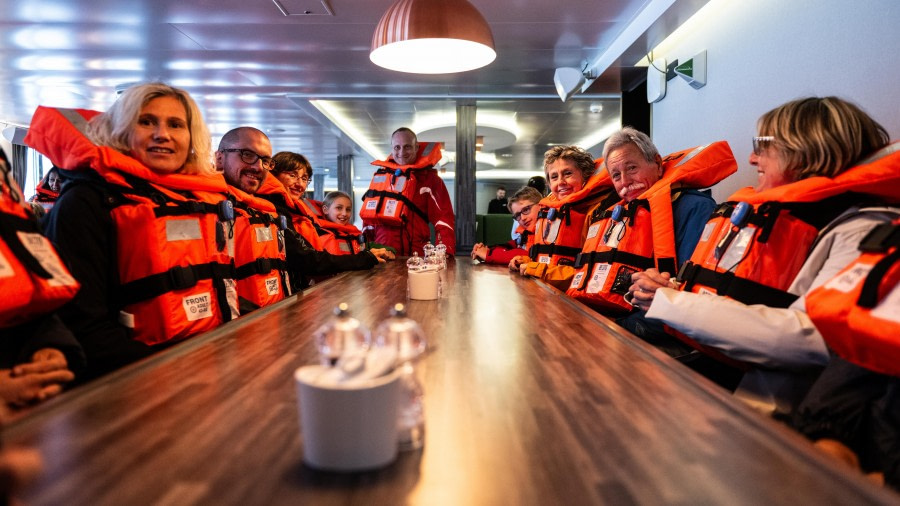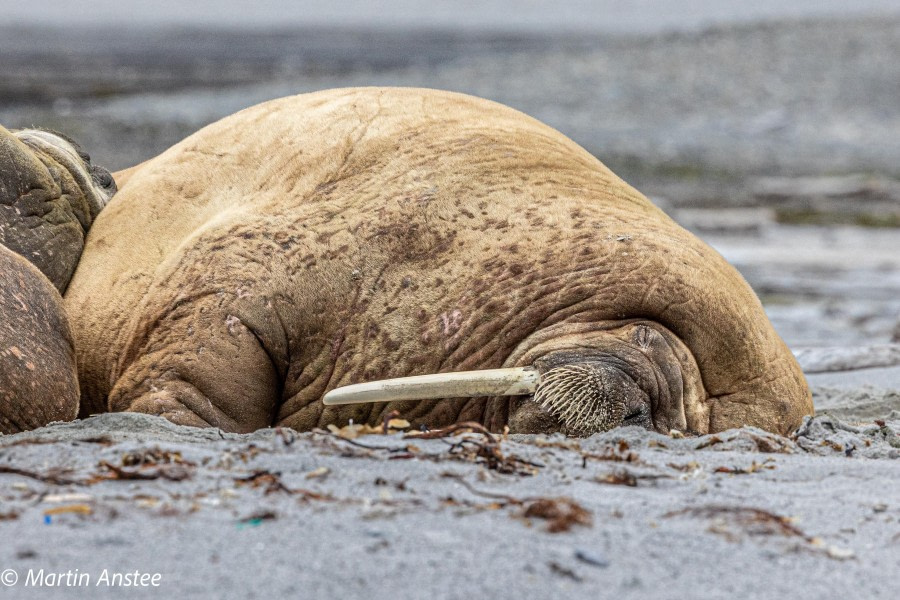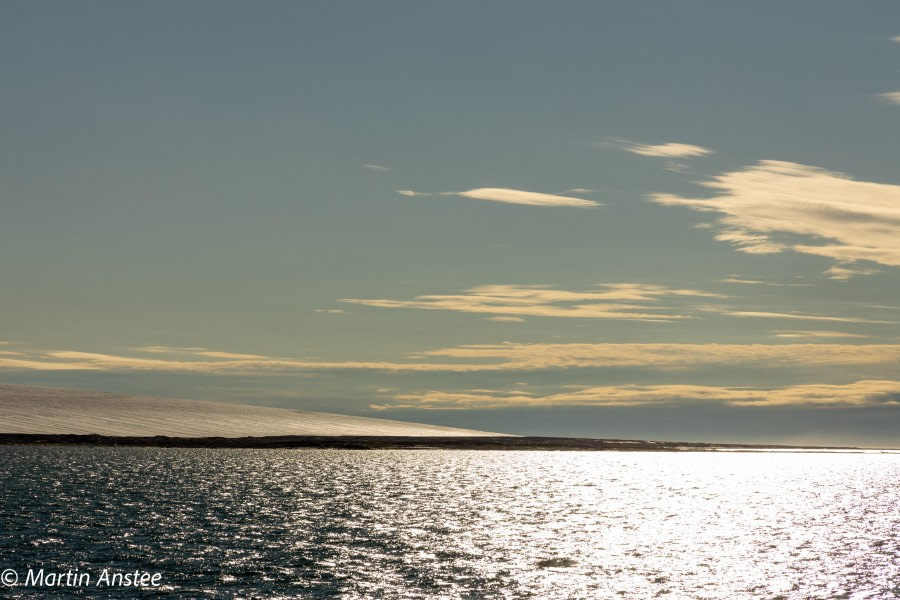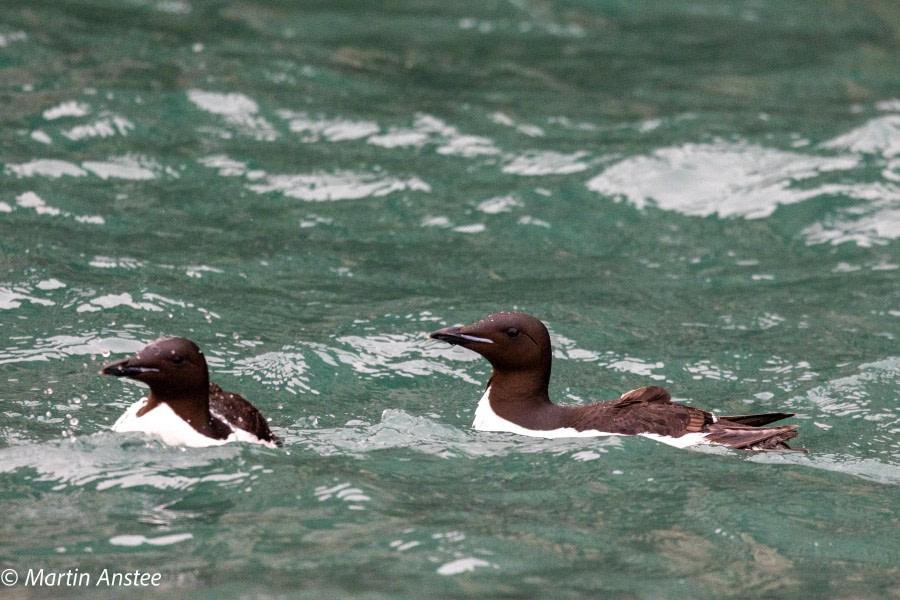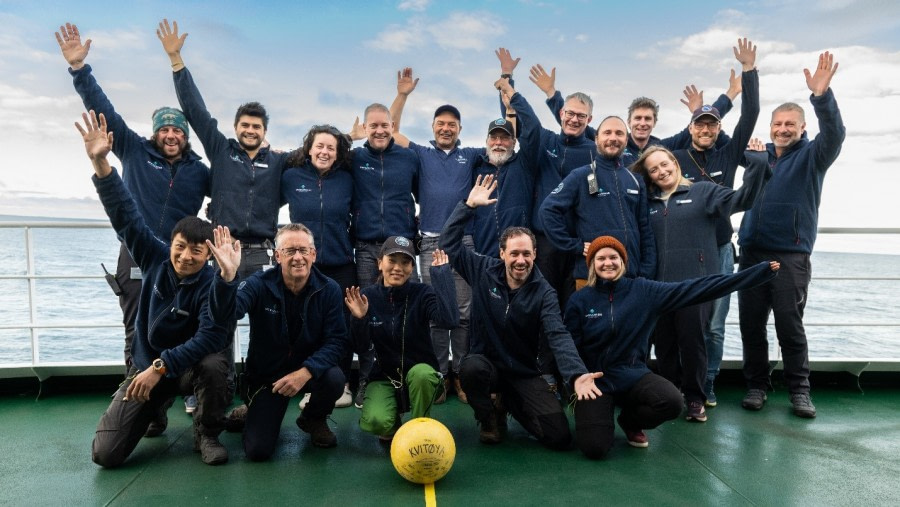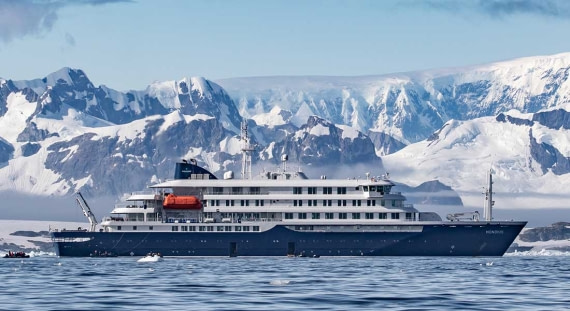| Date: |
13.08.2023 |
| Position: |
81°02.2’N / 024°32.3’E |
| Wind: |
ENE 3 |
| Weather: |
Cloudy |
| Air Temperature: |
-1 |
What do you know about the color gray? It seems you truly come to appreciate this hue only once you've ventured into the Arctic. The gray skies looming over our ship displayed an array of shades. Aft, a dark gray cluster of layered clouds enshrouded the Spitsbergen land that was no longer visible to us, while ahead, the same layered clouds displayed an almost white hue. How can this be, you may ask? Well, it's quite simple: the color of clouds is directly influenced by what lies beneath them, whether it's the land or water surface. If it's dark, bare rocks, the clouds above will be dark as well, but if it's snow or ice, the clouds will be bright and white. This was how intrepid explorers of polar latitudes in times past gained insight into where to steer their frigates or barks.
Hondius was headed northeast towards the pack ice of the Arctic Ocean. A moderate wind was blowing, and the small waves attacked the ship's port side. Judging by the almost white hue of the sky directly on course, there wasn't much distance left to the pack ice.
And here it was, the eternal ice! At first, we encountered solitary ice floes, melancholically drifting aimlessly, swaying on the waves. But then, before our eyes, small clusters of ice floes emerged, followed by larger groups, and finally, a vast white expanse appeared – a field of ice floes colliding and brushing against each other. This was the real Arctic! Once, we read about it in geography textbooks, and now we were seeing it with our own eyes!
From the early hours of the morning, our guides took turns on the Bridge, peering into the distance and adjusting the lenses of their binoculars. Yes, one of the objectives for this day was to venture into the ice, but another equally important goal was to spot a white and fluffy representative of the local fauna! Therefore, our guides, exerting maximum effort and sparing no strain on their eyes, section by section, scanned the ice's surface. There, a uniquely shaped floe; here, a lone harp seal lounging on an ice floe; over there, a black-legged kittiwake perching. And look, who's that strolling lazily from foot to foot? Let's take a closer look... It's a Polar Bear!!!
We were just finishing breakfast when Marcel, our expedition leader, made the long-awaited announcement: "Friends, we have just spotted a Polar Bear! Dress warmly and head out to the open decks, while we approach it more closely." Immediately, we rushed to put on warm clothing. Meanwhile, Ernesto, our captain, skillfully navigating between the ice floes, steered the ship towards the bear.
And there it was, right nearby! We all rushed to the deck, aiming our binoculars, camera lenses, and phone cameras at it. But wait, why do we keep saying "bear" all the time? As it turned out, this was a young, beautiful, and graceful female polar bear!
She turned out to be curious: pacing back and forth along the ship's sides, occasionally stopping to raise her head, sniffing the air, and trying to understand what strange and unfamiliar scents were wafting from different corners of this perplexing floating contraption. What were these mammals standing and gazing at her?
We stood there, clicking the shutters of our cameras, occasionally moving from one deck to another to get a better view. After some time, our furry friend lost interest in us. She hopped from one ice floe to another, moving on to her own business. We watched her go and headed indoors to warm up, have hot tea, show off our fresh photos to each other, and watch the videos we had captured on our phones.
Soon, our guides Jakub and Jerry invited us to join them in the lecture room and observation lounge, respectively. They had planned to give us a lecture on the nature of ice and its various forms, but things took an unexpected turn! Captain Ernesto had found us another bear! Naturally, the lecture had to be postponed. Once again, we dressed warmly and hurried to the open decks. This time, it was a male bear, approximately the same size and age as the female we had encountered earlier. His curiosity about who we were and what we were all about seemed even greater than that of our morning guest. He circled the ship, sniffing the air, and posed eagerly for photos. He stretched his neck, sat down, lay on the ice, and jumped from one floe to another. Quite some time passed before his curiosity subsided. Continuously looking around, he gradually melted into the boundless expanse of the eternal ice.
Hondius continued forging her path, slowly parting the small ice floes and navigating around the larger ones. Midday had come and gone. Lunch began and ended, after which Jakub and Jerry called us to re-join them for the lecture, but, once again, fate had other plans. This time, it was a Walrus, another prominent member of the Arctic fauna. Huge and unwieldy, it had hauled itself onto an ice floe, where it slept peacefully, occasionally shifting its weight. We approached it so closely that even without binoculars, one could make out its lengthy tusks. The Walrus lazily opened its eyes, lifted itself onto its front flippers, and bestowed upon us a look brimming with disdain. Then, it reclined on the ice once more and promptly dozed off.
A small group of four ivory gulls sat nearby. These rare and beautiful birds intermittently approached the walrus, trying to figure out if it could be their next meal. Realizing that they had absolutely no chance of eating the walrus, they perched for a while longer before fluttering up into the sky and disappearing.
We returned to the observation lounge and lecture room, where Jerry and Jakub were eagerly awaiting us, ready to share their knowledge about the nature of ice, but... alas! Before we could even settle in, a new announcement echoed through the ship that a Polar Bear was approaching. We looked out the window and indeed, there he was, a magnificent specimen, heading straight towards us! With cameras in hand and jackets hastily zipped up, we hurried to the open decks, taking up positions of anticipation. But it seemed the bear was no fool; he knew a thing or two about satire and irony. Just about a hundred meters shy of the ship, he found a more comfortable ice floe, settled in, and dozed off. There's a suspicion he wasn't sleeping at all, but lying there, casting sneaky glances at us from under his eyelids, quietly chuckling to himself as he observed us standing there freezing, cameras at the ready.
A comical scene had unfolded: the ship stood amidst a vast expanse of eternal ice, a Walrus napped on its left side, a Polar Pear lounged on its right, while in the lecture room, Jakub lay on the couch, gazing at the ceiling, contemplating and trying to understand what was happening and when it would all end.
The hotel department decided to surprise us: in celebration of crossing the 81st parallel, they treated us all to ice cream. Tables were set up on the ship's deck, plates of colorful chocolate and vanilla ice cream scoops were served, and despite the cold weather, we eagerly indulged in this treat, periodically glancing to check if the bear had awakened. Nope, still sleeping, that rascal! Well, so be it, we'd have to move on.
After enduring the cold outside for a while longer, we finally retreated indoors. An announcement was made about the start of the lecture on the nature of ice. Hondius set off and slowly continued its journey northeast, navigating through tightly packed ice floes. Jakub surveyed the attentive audience, took a deep breath to deliver his welcoming words and delve into the world of ice, but then – oh, what a nuisance! – the bear woke up.
"Damn it!" Jakub muttered through his teeth and, informing everyone that he was going for negotiations with the bear, left the lecture room. And what did we do? Well, we went after our jackets and cameras, too. And this time, let me tell you, it was truly worth it!
The bear approached very close. For those of us with massive telephoto lenses on our cameras, we had to quickly switch lenses because the bear just didn't fit in the frame! By the way, upon observing the bear in all its detail, we realized it was our morning guest. Whether it was because he really liked us or he had some additional questions about our essence, he went out of his way to follow us for a whole six kilometers, just to take another stroll right under our noses. Having thoroughly filled up our SD cards, he eventually wandered off.
The rest of the day unfolded in a relaxed manner. Jakub and Jerry, now with no competitors to vie for our attention, finally told us about the nature of ice. In the evening, the daily recap took place, followed by dinner.
After dinner, Sasha, one of the guides, gathered those interested in the lecture room, where he shared stories of his life in the Soviet ghost town of Pyramiden, accompanied by a presentation of his photos and videos.
Around 11 o'clock at night, an announcement rang out that, believe it or not, we had found two more bears! Though already experienced and tired, we still went to see them. A huge, fearsome white bear was tearing at the carcass of either a seal or a walrus, feasting on its bloody dinner. Meanwhile, another bear was sneaking in the direction of the first, pondering on the go whether it would be safe to join the feast.
By nighttime, the weather had really cleared up. The sun shone brightly, and a calmness prevailed. A wonderful and unforgettable day!
